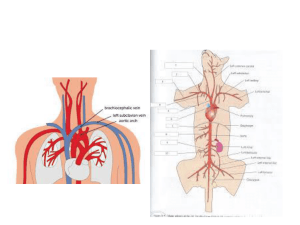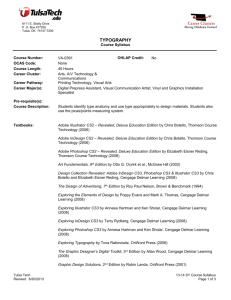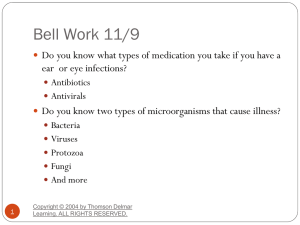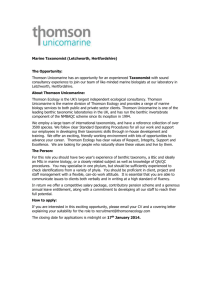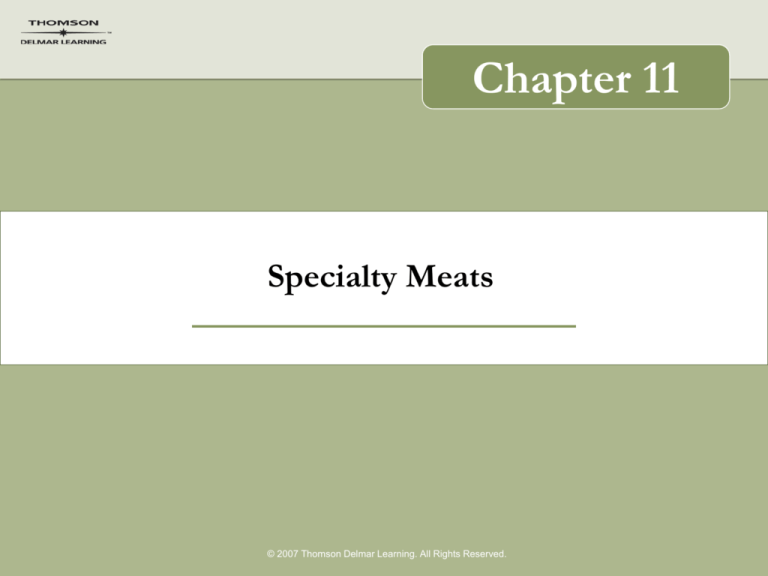
Chapter 11
Specialty Meats
© 2007 Thomson Delmar Learning. All Rights Reserved.
Offal/Specialty Meats/Organ Meats
• The word offal comes from the Old English
“off ” and “fall” referring to the pieces that
fall from the animal carcass during butchering
• Other names: offal cuts, specialty meats, organ
meats, variety meats, bad meats, and cheap meats
© 2007 Thomson Delmar Learning. All Rights Reserved.
Liver
• If liver is going to be cooked by any dry method of
cooking, great care must be taken to ensure that it is
not overcooked
• If overcooked, it will harden, toughen, and change
flavor considerably
• The thinner the cut, the faster it will need to be
cooked
• Inaccuracy in removal of the silver skin can cause
curling of the liver during cooking resulting in poor
presentation and toughness
© 2007 Thomson Delmar Learning. All Rights Reserved.
Beef Liver
• Quality Factors
– Should have a bright color with a moist but not
slimy surface and fresh smell
– Is darker and has a stronger taste than all other
livers
– Is generally toughest of all livers
– Can weight 8 to 12 pounds
© 2007 Thomson Delmar Learning. All Rights Reserved.
Calf ’s Liver
• Should be deep rose to reddish brown in
color
• Should not have any dark red or purple tinges
• Should not have any blood spots or bruising
• Should weight on average 7 pounds
© 2007 Thomson Delmar Learning. All Rights Reserved.
Lamb Liver
• Has sharp and distinctive odor
• Very light reddish brown in color
• Color should be lively and have a bright
bloom; should not show any sign of dullness
• Resembles calf ’s liver, and is sometimes
mistakenly sold as calf ’s liver
• Generally very tender
© 2007 Thomson Delmar Learning. All Rights Reserved.
Lamb Liver
• Weighs on average about 2 pounds
• Dries very quickly if overcooked
© 2007 Thomson Delmar Learning. All Rights Reserved.
Pork Liver
• Has a strong odor and flavor
• Color should be lively and have a light
reddish brown tinge
• Weighs on average 3 pounds
• Is primarily used in the production of pâtes
and sausages, although it can be sautéed and
fried
© 2007 Thomson Delmar Learning. All Rights Reserved.
Cleaning Liver
• Wash well and pat dry
• Remove any tough membranes, tubes, and
sinews
• Take great care not to damage the structure
during removal of veins
• Skin the liver by removing tough silver skin
that surrounds it
• Slice as desired
© 2007 Thomson Delmar Learning. All Rights Reserved.
Chicken and Duck Liver
• Quality Points
– Should be firm and well shaped
– Should not have any evidence of the gallbladder
remaining—easily recognized by green staining
– Should be a rich dark reddish brown with a
bright bloom
– Should be intact, not mashed or damaged in any
way
© 2007 Thomson Delmar Learning. All Rights Reserved.
Foie Gras
• Romans (1st century BC) realized that goose liver
was greatly improved when the geese were fed fresh
figs
• Ashkenazi Jews of central Europe are credited with
disseminating the method of cultivation of foie gras
• Escoffier created step-by-step instructions on
preparing the liver for foie gras as we know it today
• Literal translation from the French is “fat liver”
© 2007 Thomson Delmar Learning. All Rights Reserved.
Foie Gras
• Quality Points
– Color should be light yellow to amber
– The lighter the liver, the less fat is contained in
the liver
– Should be firm and resilient to touch
– Should give slightly under thumb pressure, and
the thumb mark should remain visible
– The higher the grade, the fewer blemishes should
be present
© 2007 Thomson Delmar Learning. All Rights Reserved.
Foie Gras
• Quality Points
– Grade A livers must weigh at least 1½ pounds
– Grade B livers should weigh between ¾ and 1½
pounds
– Grade C livers were less than 1 pound
– The size of the liver will determine how much
vein is contained within
© 2007 Thomson Delmar Learning. All Rights Reserved.
Foie Gras
• Quality Points
– Finest livers should be relatively free of any
bruises or blemishes
– Surface blood spots, or small red pin dots,
indicate a breakdown of capillaries or an
excessive number of veins that will affect the
flavor and texture of the finished dish
© 2007 Thomson Delmar Learning. All Rights Reserved.
Foie Gras
• Quality Points
– Generally sold in individual vacuum-sealed packages and
should remain in packages until ready for use
– Will keep for 2 weeks in vacuum seal in the refrigerator
– Best when used within 1 week of purchase
– When removed from vacuum package, use immediately,
or wrap tightly in plastic and use within 48 hours
© 2007 Thomson Delmar Learning. All Rights Reserved.
Foie Gras
• Quality Points
– Freezing and defrosting destroy cell walls within
the foie gras, allowing moisture to evaporate
– Residual blood left in veins can be removed by
soaking in milk for 2 hours (may not be
necessary because of modern processing)
– Goose liver is slightly larger than duck liver
© 2007 Thomson Delmar Learning. All Rights Reserved.
Foie Gras Preparation
• Hot Preparation
– Using a slightly chilled liver, separate the lobes by
gently inserting your hands between the lobes,
and with one lobe in each hand, pull them apart
– Use a sharp knife to cut the connective
membranes and nerves between the lobes
– Trim away any visible membranes, veins, and
green bile
© 2007 Thomson Delmar Learning. All Rights Reserved.
Foie Gras Preparation
• Hot Preparation
– Cut lobes into medallions of differing sizes
depending on the method of cooking
– Always use a sharp knife dipped in hot water and
slice the liver on a diagonal
© 2007 Thomson Delmar Learning. All Rights Reserved.
Foie Gras Preparation
• Cold Preparation
– Remove the Vein:
• Bring the liver to room temperature by removing the
foie gras from the vacuumed package, rinsing well,
and immersing it in a water bath of 95ºF (35ºC).
• After soaking for one hour, the liver will be pliable
enough to clean
• Separate the two lobes and, with the larger lobe lying
upside down, find the area where the connecting
membranes and veins have been cut
© 2007 Thomson Delmar Learning. All Rights Reserved.
Foie Gras Preparation
• Cold Preparation
– Remove the Vein:
• Gently tug the membrane to reveal the location of the central
vein of the lobe; as you pull, use your other hand to gently peel
back the flesh of the liver, tracing the location of the vein
• Clean the foie gras without breaking it into pieces; the central
vein reaches roughly two thirds down the middle of the large
lobe before it forks into two separate directions, forming an
upside-down “Y”
• Remove it gently, following it at all times; remove all membranes
at the same time as the veins
© 2007 Thomson Delmar Learning. All Rights Reserved.
Foie Gras Preparation
• Cold Preparation
– Remove the Vein:
• You should have a somewhat flattened but intact lobe
• Do the same for the other lobe
• Discard the membranes and veins; using the cleaned
lobes, continue with the recipe
© 2007 Thomson Delmar Learning. All Rights Reserved.
Sweetbreads
• Most delicately flavored of the offal meats
• Most sought after for their subtle flavor and
wonderful texture
• They are the small thymus glands from the neck and
heart of young steers, calves, and lamb
• The round lobe is found near the heart
• The longer elongated lobe is from the throat in the
neck of the animal
© 2007 Thomson Delmar Learning. All Rights Reserved.
Sweetbreads
• Quality Factors
– Should be light, bright, and rosy in color
– The larger size is more desirable
– Should not have any blood spots or bruising
visible
– Outer membrane is removed either before or
after cooking
© 2007 Thomson Delmar Learning. All Rights Reserved.
Cooking Sweetbreads
• Soak in cold water for about 6 to 8 hours,
changing the water often
• Blanch in simmering water with a little lemon
juice or vinegar added for about 2 minutes to
help firm their texture and prepare them for
trimming
• Chill immediately and pat dry
© 2007 Thomson Delmar Learning. All Rights Reserved.
Cooking Sweetbreads
• Carefully trim off all tubes, sinews, and any
fat, pressing very lightly between 2 boards to
even their size
• The sweetbreads can now be larded or
studded as desired
• They are braised brown or white, sautéed, or
fried
© 2007 Thomson Delmar Learning. All Rights Reserved.
Tongue
• Quality Points
– There should be no throat bones or cartilage attached
– Wash well in cold water to remove any blood
• Cooking
– Tongues should be soaked in acidulated water for an hour
or in plain water overnight if the tongues are to be salted
– Tongue has a thick outer layer of skin and requires a long,
slow, moist cooking method to make it tender enough to
eat
© 2007 Thomson Delmar Learning. All Rights Reserved.
Tongue
• Cooking
– Cook by poaching, and when it is fully cooked, quickly
plunge into cold water; the skin is then split and peeled
off like a glove
– Before serving, cut away any roots, small bones, or gristle
that might still be present at the neck end
– Tongues can be pickled and pressed into shapes before
cutting, but this must be done after skinning and before
they are completely cooled
© 2007 Thomson Delmar Learning. All Rights Reserved.
Heart
• Quality Points
– Hearts should have a fresh smell and red color not brown
or gray
– Store loosely wrapped in the refrigerator for no more
than 3 days
• Cooking
– All hearts should be thoroughly washed before cooking,
and the membrane inside that divides the two heart
chambers should be removed, particularly if the heart is
to be stuffed
© 2007 Thomson Delmar Learning. All Rights Reserved.
Heart
• Cooking
– Open the heart without separating halves
– Trim off excess fat and tubes
– Remove clots of blood and sprinkle with olive oil
and lemon juice
– Marinate for 1 to 2 hours and season with salt
and pepper
– Stuff with pork forcemeat or savory stuffing
© 2007 Thomson Delmar Learning. All Rights Reserved.
Heart
• Cooking
– Wrap in larding bacon (cut paper-thin) or in pig’s
caul
– Tie well with string and cook gently by roasting
or braising
– Alternately, the heart may be sewn closed for
cooking
© 2007 Thomson Delmar Learning. All Rights Reserved.
Kidneys
• Rules for purchase:
– Should not appear limp or have a strong smell
– Are highly perishable and should be prepared
promptly after they are purchased
– Should have a bright appearance and should not
appear shriveled in any way
– Should be firm, pink, or pale red rather than
purple, and should not have a uric acid smell
© 2007 Thomson Delmar Learning. All Rights Reserved.
Lamb Kidneys
• Preparation for cooking:
– Slit on bulging side and open without separating
the two halves
– Remove the skin, trim tubes, skewer to keep
kidney open
– They can be divided into 2 halves lengthwise;
skin and trim
© 2007 Thomson Delmar Learning. All Rights Reserved.
Pluck
• Rules for preparation:
– The lungs should be beaten vigorously to expel air, and
the spleen should be skinned
– They should be soaked in cold water with salt for 24
hours to remove the blood
– Blanch spleen and lungs in salt water for 10 minutes;
Slice it thinly and fry in clarified butter
– Alternately, they should be lightly poached for 1½ hours
until tender and used for stuffing and sausage
© 2007 Thomson Delmar Learning. All Rights Reserved.
Brains
• Quality Points
– Choose brains that are clean, light pink color, and
free of blood clots and stains
– Brains should be firm, plump, and pinkish white
– Chill well and use the same day as purchased
© 2007 Thomson Delmar Learning. All Rights Reserved.
Brains
• Preparation for Cooking
– Before precooking, soak the brains in cold water
and remove the outer membrane
– Brains should be soaked in cold water until all the
blood is leached away; the arteries and fibers
should then be removed
– Precooking is, in fact, a prerequisite to most
methods of preparation and enhances the
keeping quality of the brains
© 2007 Thomson Delmar Learning. All Rights Reserved.
Brains
• Preparation for Cooking
– Simmer them for about 20 minutes in salted water, adding
1 or 2 tablespoons of lemon juice or vinegar, and other
seasonings if you desire
– Another method is to simmer them in milk; this step will
firm their mushy consistency for use in other recipes
– The brains are rested and cooled before the next method
of cooking takes place
– They may be sautéed or cut in small pieces and deep fried
in batter or other coatings, fried, creamed, or scrambled
with eggs
© 2007 Thomson Delmar Learning. All Rights Reserved.
Blood
• Considerations for Cooking
– Fresh blood straight from the animal is at great
risk for spoiling unless dealt with immediately
– A little lemon juice or vinegar should be added to
stop the blood from clotting during refrigeration;
1 tablespoon (15 mL) of lemon juice per 2 quarts
(1.9 L) of blood is the recommended ratio
– Store the fresh blood for no more than 2 days
© 2007 Thomson Delmar Learning. All Rights Reserved.
Head
• Quality Points
– Check the neck for obvious signs of bruising and
damaged flesh
– Ensure that the windpipes have been removed
– Clean the ears, nose, and mouth areas of
anything that looks unclean
– Wash the whole head thoroughly
© 2007 Thomson Delmar Learning. All Rights Reserved.
Head
• Preparation for Cooking
– Make an incision down the center of the head from the
top of the forehead to the nose of the animal
– Run your knife along the meat, keeping the flesh attached
to the skin but following the contour of the skull until
you have completely boned the head
– Take the greatest care to keep your knife facing the bone
at all times in order to remove as much flesh as possible
– Follow the head from top to bottom around the
forehead, then around the eyes along the snout and then
along the jaw
© 2007 Thomson Delmar Learning. All Rights Reserved.
Head
• Preparation for Cooking
– Lay the skin out flesh side up; clean around the ears,
nose, and tongue end, removing any cartilage and sinews;
remove all large fat pockets that are visible, cleaning
down to the flesh
– Remove the tongue and cut into strips about 3 inches by
½ inch (7.5 cm by 1.25 cm) and reserve
– Now remove the skin by using a long firm ham knife and
cutting under the flesh against the skin as if skinning a
large salmon fillet
© 2007 Thomson Delmar Learning. All Rights Reserved.
Head
• Preparation for Cooking
– Lay the flesh into the best rectangle you can make from it
in between 2 sheets of strong plastic wrap and lightly
beat the head into a somewhat even-looking sheet
– Roll this up with the tongue inside, seasoning well as you
go
– Tie in muslin into a galantine shape and secure with
butcher’s twine
– Poach for 3 hours, very gently, until fully cooked
– Cool until you can handle it, and then rewrap and tie
tightly to create its final shape in fresh muslin, allowing it
to chill in the cooking liquid
© 2007 Thomson Delmar Learning. All Rights Reserved.
Tripe
• Cooking
– Soak in acidulated water overnight and wash well
the next day in plenty of running cold water
– Cut into strips about 4 inches (10 cm) long and 1
inch (2.5 cm) wide
– Braise or poach in rich court bouillon or good
beef broth until tender
– Add to an appropriate sauce and serve
© 2007 Thomson Delmar Learning. All Rights Reserved.
Tails
• Quality Points
– Look for tails with an even distribution of meat and fat
– They should have an even coating of very white fat
– They should be skinned and trimmed of excess fat
• They can be bought cut into chunks through
cartilage between segments of bone
• They can also be boned without damaging skin;
season with salt and pepper and stuff; Roll and tie
with cloth and string, like a galantine, for cooking
© 2007 Thomson Delmar Learning. All Rights Reserved.
Caul Fat
• Pig’s caul fat is the lining of a pig’s stomach
• The excess fat is removed and can be used as lard
• The remaining membrane is used as a protective
wrapping for any meat item that needs to have a
“natural plastic wrap” to hold it together during
cooking
• Soak it in salt water and then drain well before using
© 2007 Thomson Delmar Learning. All Rights Reserved.
Caul Fat
• It can be very delicate, so handle with care
• It will mostly disappear when cooked, except
when it has been wrapped repeatedly around
a food item
© 2007 Thomson Delmar Learning. All Rights Reserved.



